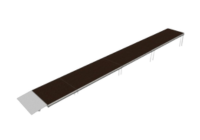Stage Ramps
Access equipment seldom receives the same headline attention as lighting, sound, or decor, yet it carries equal importance. A well-built ramp for stage duties bridges the gap between ground level and the raised performance deck, ensuring that artists, crew, and guests move smoothly and safely. From touring theatre troupes to school assemblies, the right solution removes barriers, speeds up load-ins, and keeps health-and-safety officers content.
Why Reliable Ramps Matter
A live event moves quickly. Flight cases roll in, scenery moves out, musicians swap one set of equipment for another. Any delay multiplies across the schedule. Stage ramps reduce that risk by providing a consistent, predictable route: no lifting, no juggling bulky gear on narrow steps. For wheelchairs and mobility scooters the benefit is obvious, but even a small incline makes all the difference when pushing trolleys laden with amplifiers or props. Beyond convenience, legislation demands inclusive access; ignoring it is seldom an option.
Core Design Elements
Longevity and safety stem from smart design, not marketing slogans. Several technical factors influence the buying decision:
- Gradient control: A gentle slope, commonly 1:12 within the UK, minimises effort for wheelchair users and keeps manual handling guidelines intact.
- Surface texture: The top surface of the decks are coated with a 'Hexa' material, which improves grip to avoid slipping in both dry and wet conditions.
- Side protection: Optional stage handrails provide extra reassurance on longer runs.
- Modular construction: Individual panels or truss-based assemblies allow quick length adjustments to suit changing venues.
- Weight rating: A specification that exceeds the heaviest anticipated payload - think fully loaded flight case - guards against structural fatigue.
Portable Stage Ramps: A Flexible Choice
Touring shows, conference organisers, and hire companies rarely encounter the same layout twice. Portable stage ramps answer that challenge with lightweight, sectional builds that travel easily. Sections often fold or pin together without tools, trimming set-up time when schedules run tight. Although weight saving is a design goal, structural stiffness remains non-negotiable; engineered box frames or ribbed extrusions handle significant point loads with a comfortable safety margin.
Advantages in Mobile Environments
- Compact storage footprints, ideal for transport vans or venue cupboards.
- Fast deployment thanks to integrated locking pins or cam clamps.
- Compatibility with multiple deck heights through interchangeable leg kits or spacer blocks.
- Straightforward maintenance; damaged sections swap out without specialist tools.
Planning a Stage with Ramp Incorporated
Treating access as an afterthought often leads to awkward angles, visual clutter, and frustrated crew. Designing the performance area and the ramp as a single package produces cleaner sight-lines and better traffic flow. Position, gradient, and turn radius must align with the natural movement of performers and equipment alike. In some halls a straight run works best; in tight rooms a dog-leg design keeps the footprint compact without compromising usability.
Key Questions During Layout
- Does the route interfere with audience aisles or fire exits?
- Will large scenery pieces clear overhead rigging while on the ramp?
- Can lighting operators maintain an unobstructed line of sight?
- Is the finish aesthetically sympathetic to the main deck?
Routine Inspection & Upkeep of the Ramp For Stage
Even the toughest materials benefit from a quick visual once-over before every show. Look for loose fasteners, surface delamination, or unexpected flex. Small issues caught early cost little to fix; ignored, they invite accidents. A simple logbook noting inspection dates, minor repairs, and replacement parts supports due-diligence paperwork without adding needless admin.
Support from Industry Specialists
Selecting a ramp may seem straightforward until the measuring tape appears. Differences in deck height, floor level, and available run length can nudge the design in multiple directions. Experienced advisers decode the regulations, confirm structural calculations, and prepare clear drawings that installers appreciate. Swift answers shorten the buying cycle, preventing last-minute compromises.
Snapshot of Benefits
- Inclusive access for performers, crew, and audience members.
- Smoother logistics: rolling gear replaces hand-carried loads.
- Compliance with UK accessibility legislation.
- Modular kits adapt to touring schedules and venue reshuffles.
- Durable, low-maintenance construction for long service life.
Decision-Making Tips at a Glance
A quick reference for anyone short on time:
- Measure correctly: Deck height governs run length. Miss the maths and everything else unravels.
- Prioritise non-slip: Surfaces should offer grip under trainers, heels, or wheelchair tyres.
- Look at load capacity: Over-spec rather than under-spec. Unexpected equipment appears on every production.
- Plan storage: Folding models save precious metres inside hire warehouses and transport cases.
Portable Stage Ramps in Education
Schools juggle concerts, assemblies, drama rehearsals, and awards evenings, often in the same hall. Portable stage ramps help technicians reset spaces quickly between events without specialist contractors. A two-person crew can usually unfold the sections, pin them in place, and roll the piano up within minutes. When term finishes, the units stack safely in store cupboards, waiting for autumn productions or parent-teacher evenings.
Live Music & Touring Productions
Tour managers assess weight, pack-down size, and set-up speed before signing purchase orders. Portable stage ramps designed for life on the road adopt reinforced hinge lines, replaceable foot pads, and lockable casters for quick moves across truck tail-lifts. Stowage proofs include impact tests, to survive rough handling, and real-world rehearsal spaces, where the kit encounters the occasional drinks spill or errant drum case.
Future-Proofing the Investment
Venues evolve: seating banks expand, orchestras add risers, film crews commandeer corners for broadcast feeds. Choosing a ramp system with bolt-on extensions and a wide accessory list cushions that growth. Handrails today, maybe a landing platform next season, modularity eases the upgrade path while protecting the initial outlay.
Common Missteps to Avoid
- Underestimating total run length, leading to a gradient that feels like a hill climb.
- Ignoring line-of-sight for cameras; a misplaced slope can block the hero shot.
- Mixing finishes: polished aluminium beside matt black decking draws the eye for the wrong reason.
- Leaving no buffer for door swings or backstage storage, causing unnecessary manoeuvring.




